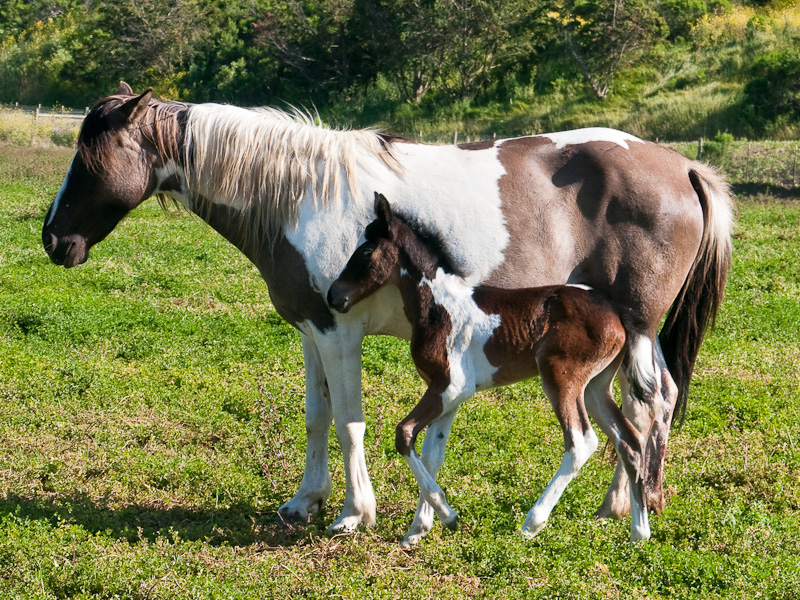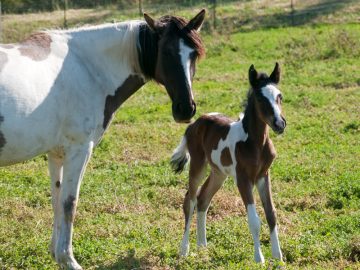Colored Horses – Pintos, Multicolored Beauties
 Pintos can be found in all kinds of breeds and crossbreeds; sometimes these are referred to as Indian horses.
Pintos can be found in all kinds of breeds and crossbreeds; sometimes these are referred to as Indian horses.
To some it matters which breed the horse descended from: That means that the horse is supposed to have a close resemblance to one particular breed, the only difference being that it shows color. Generally, with colored horses it is not a matter of a horse breed but color breed.
Eight different Pinto types
If you look around in the breeding community you soon realize that Pintos are usually horses that unite all the characteristics of one specific, already existing breed now combined with a new look. In some cases however, Pintos may occur more or less randomly, without a plan for a mixed breed – perhaps these in particular are the more interesting horses. Basically though, it’s really more a question of aesthetics, or rather, the desire for a tailor-made horse: You want the characteristics of a certain breed, but this time, add a color coat, please. The word Pinto doesn’t refer to a particular horse breed it refers to a color breed instead. The word originates from the Spanish “pintado” which means painted and describes this horse well. To call a horse a Pinto it has to have patches of color, which means that the color has to be present at birth already. For an overview of Pintos we list the most well-known here.
Baroque Pinto
Baroque Pintos win the hearts of color-breed lovers by sheer appearance: A perfect union of elegance and power. These Pintos originated in the Netherlands, stand between 14.5 and 16.5 hands and therefore qualify for Baroque classical dressage. Baroque Pintos are horses that have typically been paired with breeds such as Friesians, Berbers, Lipizzans, Lusitanos, Andalusians, and Spanish Arabians; cross breeding with Gypsy Vanners (Tinkers) has also been successful. From their exterior they look very much like Friesian horses. Their erect necks, strong breasts, and large hooves in particular remind us of them. They are favored as classical dressage horses as they are eager learners, have an even-temper, and a friendly disposition. The ancestor of baroque Pintos is the stallion Bonte Nico.
Pleasure Type Arabian Pinto
These horses should look like pure-bred Arabians, yet show a patched coat that does not appear in pure-bred Arabians. Arabian Pinto Pleasure horses measure between 14.5 and 16 hands and rank among the medium-size color horses. Breeders are aiming for a rather square body build which makes them ideally suited for various kinds of riding disciplines. Today you can already come across Arabian Pintos with more than 90% pure Arabian blood – which comes very close to the desired breeding goal. In order to be registered as a stallion at stud book 1, evidence has to be provided that the horse is at least 50% Arabian.
German Riding Pony, Pinto
For those who are looking for a small, fine color horse, there is a noble Riding Pony that stands 11.8 to 14.8 hands. With its ground-covering gallop, sweeping trot, and radiant elegance it is ideally suited for children, adolescents, and lightweight adults.
Saddle-type Pinto
Gaited horses with color are becoming more popular but are still relatively rare in Germany. Between 15.2 and 16.5 hands in height these warmbloods offer much comfort as carriage or riding horses. They are extremely comfortable to ride and in addition look very stylish with their high knee action. The saddle-type Pintos originate from pairings with Tennessee Walkers, Saddle Horses, Missouri Fox Trotters, Morgans and tolting Trotters.
Small German Riding Horse, Pinto
These horses are required to stand 15.8 hands minimum. By temperament, rideability, and great jumping capacity the Small German Riding Horse is ideally suited for dressage, jumping, and driving. The horse is also well suited for children and adolescents.
Stock-type Pinto
Stock Pintos are cross breeds with Paint horses, Paint horse cross breeds and Pintos paired with Quarter horses. With a height of 14.5 to 16 hands, square figure, and well developed muscles, Stock Pintos are ideal Western horses. In addition they are especially suitable for leisure riders as these horses are sure-footed and also very good-natured. Elegance and grace are much less distinct in these than in the Baroque Pintos for example.
Lewitzer Pinto
The highly motivated, pleasant, and all-round Lewitzer developed from pairings with Arabians, Thoroughbreds, and most of all with German Riding Ponies. At a height of 13 to 14.8 hands it is well qualified for the discriminating leisure rider and driver.
Tinker Cob (also known as Gypsy horse or Gypsy Vanner)
This breed stands between 13.5 and 16 hands and is predominantly cold blooded. With their even-tempered and good-natured disposition they have gained popularity with hobby riders. These are also very human oriented and docile horses. Most eye catching on this horse is the abundant feathering on its lower legs (which needs thorough grooming). They originally came from England and Ireland and are often marked by very light eyes. Another trademark is their abundantly flowing mane and tail hair.
Of course there are also crossbred horses that don’t fit into any of the eight Pinto-types listed here. They are marked only as “Pinto” in the pedigree papers. If a foal is “only” a Pinto and just of “one color” it is marked as such.
Paint Horse
Paint horses are Quarter Horses with color patches. Although they don’t constitute their own breed, these colorful beauties have their own organization, the American Paint Horse Association (APHA). The Paint Horse, which stands 15 to 15.5 hands is well suited even for heavy adults. By now Paints are being bred that reach 16 hands and more; they resemble our warm bloods here and are primarily used in English riding disciplines such as hunter, saddle, or pleasure. They are known to be extremely rideable, have strong nerves, well muscled bodies, and powerful hind quarters. Because of their willingness to work and their strong nerves they are ideally suited as leisure horses, and for Western and trail riding
Tobiano and Overo – Names for color patterns
Paint Horses are distinguished by two color pattern. First, the Tobiano Pinto, a horse also referred to as having a cow pattern. It shows white legs and white color crosses the top line. Pintos without a clear tobiano pattern are referred to as overos or toveros. Not matter what the Paint Horse’s size, it has to have Pinto markings.
Quarabs
Crossbreeds between Quarter/Paint Horses and Arabians are relatively unknown in Germany. The Quarab is described as: usable in many equine disciplines, good natured, intelligent, a high performance horse, enduring, calm, shows speed at short distances, good long-distance performer.
Perhaps just a step to bring more color to life … these are just a few variations, there are a lot more out there.
Surf-Tipp:
—All statements without guarantee—


One Comment
Comments are closed.